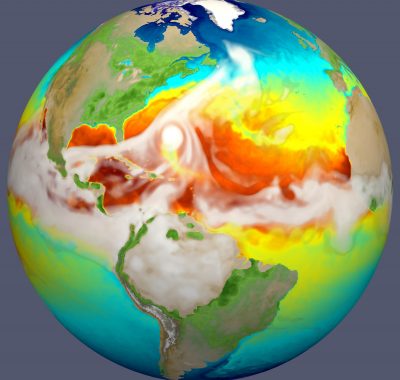The U.S. Department of Energy (DOE) has unveiled a powerful, new earth system model that uses the world’s fastest computers so that scientists can better understand how earth system processes interact today and how they may evolve in the future.
After four years of development, the Energy Exascale Earth System Model (E3SM) was recently released to the broader scientific community. The E3SM project is supported by DOE’s Office of Science in the Biological and Environmental Research Office. Its release includes model code and documentation, as well as output from an initial set of benchmark simulations.
“The mechanisms of our planet are very complex,” says L. Ruby Leung, E3SM chief scientist. “We want to represent how interactions of atmosphere, oceans, land, and ice govern the behavior of Earth as a system and predict future changes in water supply, extreme events, and coastal vulnerability. With this information, we can inform decisions to help strengthen the resilience of populations, our economy, energy resources, and national security.”
The goal of the project is to develop an earth system model that has not been possible because of limitations in current computing technologies. Meeting this goal will require advances on three frontiers:
- Better resolving earth system processes through a strategic combination of developing new processes in the model, increased model resolution, and enhanced computational performance.
- Representing more realistically the two-way interactions between human activities and natural processes, especially where these interactions affect U.S. energy needs.
- Ensemble modeling to quantify the uncertainty of model simulations and projections.

“The quality and quantity of observations really makes us constrain the models,” says David Bader, lead of the E3SM project. “With the new system, we’ll be able to more realistically simulate the present, which gives us more confidence to simulate the future.”
E3SM developers focused on overcoming previous modeling limitations by taking advantage of the latest high-performance computing technologies. With this capability, the new high-resolution, coupled earth system model will help researchers explore the challenges posed by interactions of weather-climate variability with energy and related sectors.
The project involves more than 100 scientists and engineers at multiple DOE national laboratories and universities, along with DOE programmatic contributions and collaborations. Process understanding provided by ASR, for example, helped constrain and guide researchers as they developed parameterizations of clouds and aerosols.
Phase 2 of E3SM is expected to incorporate products developed under projects for the Climate Model Development and Validation (CMDV) activity, which is tasked to improve earth system model design and to develop scale-aware physics for earth systems and enhance model validation methods. Several of these projects require collaboration between E3SM, ASR, and the Atmospheric Radiation Measurement (ARM) Research Facility.
For more information on E3SM, read the Lawrence Livermore National Laboratory news release.
This work was supported by the U.S. Department of Energy’s Office of Science, through the Biological and Environmental Research program as part of the Atmospheric System Research program.

